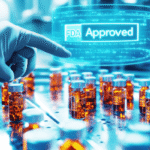
HomeDemystifying SOP Automation: Best Practices & Technology TrendsBlogsDemystifying SOP Automation: Best Practices & Technology Trends
Demystifying SOP Automation: Best Practices & Technology Trends
Covers best practices, technology trends, and benefits of automating SOPs to improve pharmaceutical compliance and efficiency.

Standard Operating Procedures (SOPs) form the backbone of pharmaceutical manufacturing and quality management. They define every critical process—from raw-material handling to final product release—and are central to regulatory compliance. Yet, in many companies these essential documents are still created, updated, and tracked manually, leaving room for errors, delays, and costly non-compliance.
This is where SOP automation in pharma is transforming operations. By digitizing and automating SOP creation, approval, and monitoring, pharmaceutical companies can cut compliance risk, improve productivity, and accelerate product launches. This article explores best practices, technology trends, and real-world lessons to help leaders embrace automated SOP pharma solutions with confidence.
Why SOP Automation Matters in Pharmaceuticals
Manual SOP management creates three persistent challenges:
- Compliance risk. Paper-based or spreadsheet systems make it easy to miss critical updates, leaving gaps in regulatory documentation.
- Slow change control. Revising and re-approving SOPs across multiple facilities can take weeks, delaying process improvements and new product introductions.
- Hidden costs. Teams spend countless hours on document routing, approvals, and training verification, diverting resources from high-value work.
Regulators such as the USFDA, EMA, and CDSCO expect continuous documentation accuracy. Any deviation can lead to warning letters, product recalls, or import bans. Automating SOPs in pharmaceutical companies reduces these risks while supporting faster, more consistent operations.
Key Benefits of Pharmaceutical SOP Automation
- Regulatory compliance and audit readiness. Automated systems ensure every SOP follows the latest guidance, with complete version control and electronic signatures.
- Quality improvement. Digital workflows reduce human error, supporting zero deviation quality across manufacturing and laboratory processes.
- Productivity gains. Automated routing and approval cut review cycles by 40–60%, freeing teams for strategic work.
- Faster market entry. Streamlined documentation supports quicker validation and product launch timelines.
Cost savings. Fewer manual steps lower administrative overhead and training expenses.
Best Practices for Pharma SOP Automation
Achieving maximum return on investment requires more than just installing software; it demands a strategic shift in process design. Successfully deploying SOP automation in pharma hinges on the following best practices for pharma SOP automation:
1. Integrating Quality Control and Assurance
The automated system must be viewed as an extension of your Quality Management System (QMS), not merely a document repository.
- Closed-Loop SOPs: The SOP should be linked directly to the operational system that executes it. For example, a batch record should automatically pull the correct, validated SOP version for that specific product and facility.
- Automating Quality Control in Pharmaceuticals: Automation should be used to enforce Quality Control checks during the execution of the process, such as mandatory digital checks before a process step can be completed, preventing errors before they become deviations.
2. Standardizing Before Automating
Do not automate a bad process. Before implementing a new system, standardize SOP formats and content across all manufacturing units and geographies. The automation tool should then enforce this standardization, not just digitize existing inconsistencies. This is crucial for multi-site organizations struggling with varying compliance standards.
3. Selecting the Right Technology Partner
- AI-Powered Process Intelligence: Tools that monitor deviations and automatically trigger CAPA recommendations.
- Regulatory Integration: A system that automatically ingests and applies external regulations (USFDA, EMA) to your internal SOPs.
These best practices for pharma SOP automation ensure technology adoption strengthens—not disrupts—your quality culture.
Technology Trends Driving SOP Automation
The digital transformation of the pharmaceutical industry is accelerating. Key pharma industry automation trends shaping SOP management include:
- AI-enabled document intelligence. Natural language processing (NLP) automatically extracts key parameters, flags inconsistencies, and suggests updates for regulatory compliance.
- Integrated CAPA management. Automated SOP platforms link deviations to corrective and preventive actions, ensuring continuous improvement.
- Cloud-native architectures. Secure cloud deployments allow global teams to collaborate on SOP updates in real time, supporting multi-site operations.
- Mobile access and e-signatures. Field and manufacturing staff can review and approve SOPs on tablets or smartphones, accelerating turnaround times.
Together, these innovations enable technology in pharma SOP automation to deliver measurable business value.
Making Compliance Your Competitive Edge
For pharmaceutical leaders, SOP automation in pharma represents a strategic opportunity to eliminate hidden costs, accelerate operational speed, and achieve true continuous compliance. By adopting these best practices for pharma SOP automation and leveraging advanced process intelligence, you move beyond the reactive burden of paperwork. You achieve a state of operational excellence where compliance is not a risk to be managed, but a predictable, automated component of your success.
Ready to transform your SOP lifecycle into a competitive advantage?
Discover how Dheera’s SOP Automation in Pharma solutions can streamline your operations and ensure continuous compliance. [Request a Demo]
FAQ: SOP Automation in Pharma
What is SOP automation in pharma?
SOP automation uses digital platforms to create, manage, and update Standard Operating Procedures, ensuring real-time compliance and reducing manual workload.
What is the biggest ROI benefit of SOP automation for a COO?
The biggest ROI benefit is the significant boost in operational productivity and reduced time-to-market. SOP automation in pharma eliminates delays in change control, speeds up deviation handling, and ensures that manufacturing teams always have the correct, validated instructions, minimizing costly downtime.
What is the role of AI in SOP automation?
AI’s role is to ensure the intelligence of the process. It interprets external regulations to suggest SOP updates, monitors processes for potential deviations, and uses predictive analytics to identify SOPs that are high-risk or prone to failure, moving the process toward Zero Deviation Quality.
How does SOP automation help with continuous Quality Improvement?
It helps by providing real-time data on process adherence and deviation frequency. This continuous flow of accurate data allows Quality Assurance teams to move from retrospective guesswork to proactive, data-driven decisions on where to allocate resources for Quality improvement.
What technologies enable SOP automation?
Modern solutions use cloud infrastructure, AI, and workflow engines to digitize documents, automate approvals, and integrate with Quality Management Systems.
What challenges should companies prepare for?
Common challenges include migrating legacy documents, training employees, and integrating new tools with existing quality and manufacturing systems.


